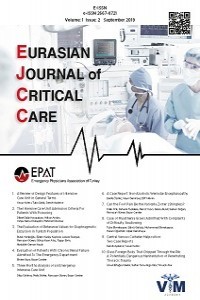Causes and Outcomes of Childhood Trauma with GCS Below 9
Causes and Outcomes of Childhood Trauma with GCS Below 9
___
- 1. Jones S, Tyson S, Young M, Gittins M, Davis NJAodic. Patterns of moderate and severe injury in children after the introduction of major trauma networks. 2019;104(4):366-71.
- 2. Naranje SM, Erali RA, Warner WC, Sawyer JR, Kelly DMJJoPO. Epidemiology of pediatric fractures presenting to emergency departments in the United States. 2016;36(4):e45-e8.
- 3. Chaitanya K, Addanki A, Karambelkar R, Ranjan RJCsns. Traumatic brain injury in Indian children. 2018;34(6):1119-23.
- 4. Stephens S, Campbell R, Chaseling R, Ma NJJocn. Traumatic brain injuries in a paediatric neurosurgical unit: a Queensland experience. 2019;70:27-32.
- 5. Allen CJ, Wagenaar AE, Horkan DB, Baldor DJ, Hannay WM, Tashiro J, et al. Predictors of mortality in pediatric trauma: experiences of a level 1 trauma center and an assessment of the International Classification Injury Severity Score (ICISS). 2016;32(7):657-63.
- 6. Nabian MH, Vosoughi F, Najafi F, Khabiri SS, Nafisi M, Veisi J, et al. Epidemiological pattern of pediatric trauma in COVID-19 outbreak: Data from a tertiary trauma center in Iran. 2020;51(12):2811-5.
- 7. Coulthard MG, Varghese V, Harvey LP, Gillen TC, Kimble RM, Ware RSJPo. A review of children with severe trauma admitted to pediatric intensive care in Queensland, Australia. 2019;14(2):e0211530.
- 8. Dolatabadi AA, Mohseninia N, Amiri M, Motamed H, Asl AHJIjoem. Pediatric trauma patients in Imam Hossein emergency department; an epidemiologic study. 2016;3(1):4-8.
- 9. Aoki M, Abe T, Saitoh D, Oshima KJSr. Epidemiology, patterns of treatment, and mortality of pediatric trauma patients in Japan. 2019;9(1):1-7.
- 10. Brehaut JC, Miller A, Raina P, McGrail KMJP. Childhood behavior disorders and injuries among children and youth: a population-based study. 2003;111(2):262-9.
- 11. Bernardo LM, Gardner MJ, Seibel KJJfSiPN. Playground injuries in children: a review and Pennsylvania Trauma Center experience. 2001;6(1):11-20.
- 12. Memarzadeh M, Hoseinpour M, Sanjary N, Karimi ZJKJ. A study on trauma epidemiology in children referred to Isfahan Alzahra Hospital during 2004-7. 2011;14(5):488-93.
- 13. Chong S-L, Khan UR, Santhanam I, Seo JS, Wang Q, Jamaluddin SF, et al. A retrospective review of paediatric head injuries in Asia–a Pan Asian Trauma Outcomes Study (PATOS) collaboration. 2017;7(8):e015759.
- Başlangıç: 2019
- Yayıncı: Acil Tıp Uzmanları Derneği
Bibliometric Analysis of Studies on Mean Platelet Volume (MPV) in the Web of Science Database
Hasan GÜMÜŞBOĞA, Muhammet Esat KARADUMAN, Ceren KARAKEÇİLİ, Mustafa BOĞAN
Causes and Outcomes of Childhood Trauma with GCS Below 9
Changiz GHOLİPOURİ, Samad SHAMS VAHDATİ, Parham MAROUFİ, Aytak KHABBAZ, Naeimeh HOSSEİNZADEH, Pouya ABBASGHOLİZADEH
D-Dimer Levels and Prognostic Features in Pulmonary Embolism
Burak KURTOĞLU, Halil İbrahim ÇIKRIKLAR, Vahide Aslıhan DURAK, Issa OMAR, Ahmet Münir YILMAZ, Sümeyye Tuğba SARKI CANDER, Erol ARMAGAN
The Influence of the COVID‑19 Pandemic on Pediatric Head Trauma
Evaluation of Nursing Home Residents Applying to The Emergency Service
Ali İhsan KİLCİ, Hakan HAKKOYMAZ, Muhammed Semih GEDİK, Levent AVSAROGULLARİ, Vesile ŞENOL, Mükerrem ALTUNTAŞ
Central Pontine Myelinolysis as a Result of Ideally Corrected Hyponatremia in a Post-Covid Patient
Julide GURBUZ, Bahadir TASLİDERE, Ahmet EMİN, Ertan SONMEZ
Ayça ÇALBAY, Atıf BAYRAMOĞLU, Erdem KARADENİZ
Bahadir TASLİDERE, Ertan SONMEZ, Ayse KARATAS, Begüm SAKIN, Rümeyza KAZANCIOĞLU
